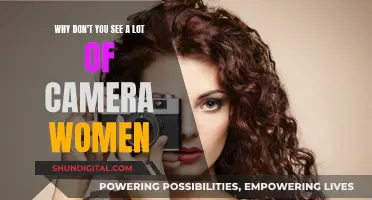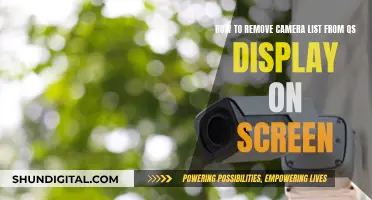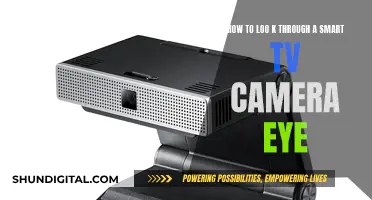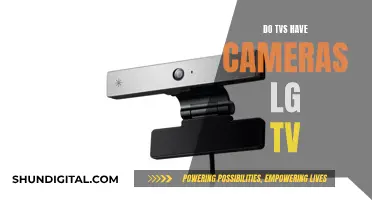
Earwax removal cameras are a popular online trend, with thousands of viral videos on social media. These devices are small, pen-like tools with inbuilt batteries, lights, and a digital camera that connects to a smart device, allowing users to see inside their ears. While these devices offer a cheap and fascinating visualisation of the ear canal, there are concerns about their safety. Healthcare professionals warn that using these devices without proper training can cause significant and lasting trauma to the ear, including damage to the ear canal, ear drum, and hearing loss. As such, it is recommended that individuals refrain from using at-home earwax removal kits and instead seek treatment from a specialist.
| Characteristics | Values |
|---|---|
| Price | Budget-friendly, as low as £9.99 |
| Design | Small, pen-like tools with LED torches |
| Functionality | Ability to stream live images or videos to a smart device |
| Usability | Difficult to use, with poor picture quality and movement lag |
| Safety | Potential to cause pain and damage to the ear canal or eardrum |
| Effectiveness | Ineffective in earwax removal, may compact wax |
| Regulation | Minimally regulated, clinically unevaluated |
What You'll Learn
- Earwax removal cameras are unsafe because they can damage the ear canal or eardrum
- They can cause infection, wax impaction, and hearing loss
- The skin of the ear canal is very sensitive and easy to damage
- They are difficult to use, with poor picture quality and movement lag
- They are not effective in removing ear wax

Earwax removal cameras are unsafe because they can damage the ear canal or eardrum
Earwax removal cameras are unsafe and can cause severe damage to the ear canal or eardrum. While these devices are marketed as safe and effective tools for earwax removal, the reality is quite different. The ear canal is extremely sensitive, with skin that is very easy to damage, and the eardrum is only 0.1mm thick. Without proper training, it is highly likely that consumers could cause significant and lasting trauma to their ears by using these devices inappropriately.
The design, materials, and functions of these over-the-counter ear cameras cannot match the quality of professional-grade equipment. The picture quality and movement lag of these devices can make it difficult to determine depth perception and the correct direction of movement, increasing the risk of injury. The novelty of being able to see inside one's ear may satisfy curiosity, but without specialised knowledge, consumers may not know what they are looking at and could misdiagnose ear-related problems.
Even with the aid of a camera, earwax removal is a delicate process that requires skill and experience. In the hands of an untrained user, the metal loops or tips of these devices can scrape and abrade the sensitive skin of the ear canal, causing pain and irritation. Improper use may also result in a punctured eardrum, which can lead to immediate sharp pain, ringing in the ear, and hearing loss.
Furthermore, earwax removal cameras can be ineffective in actually removing earwax. The metal loops attached to these devices may move around too much, making it difficult to remove earwax even with proper instrumentation. In addition, the camera itself may be too big, leaving insufficient room in the ear canal to insert the camera and effectively remove the earwax.
In conclusion, earwax removal cameras are unsafe and can cause serious damage to the ear canal or eardrum. These devices are not worth the risk of causing lasting injury to one's ears. It is strongly recommended to seek treatment and diagnosis from a specialist or licensed professional, such as an audiologist, hearing instrument specialist, otologist, or otolaryngologist.
Wyze Camera: Is Someone Spying on You?
You may want to see also

They can cause infection, wax impaction, and hearing loss
Earwax removal cameras are small, pen-like tools with inbuilt batteries, lights, and a digital camera. They connect to a smart device via cable or wireless connection, allowing users to view their ear canal in real-time as they manipulate the tip to remove wax. While these devices are marketed as safe and cost-effective solutions for earwax removal, there are several risks associated with their use.
Firstly, the skin of the ear canal is very sensitive and easy to damage. The ear drum, for instance, has a thickness of only 0.1mm. The untrained use of earwax removal cameras can lead to scratching or abrasion of the ear canal, causing pain and potentially damaging the ear drum. This can result in immediate sharp pain and lead to further complications such as ringing in the ear or hearing loss.
Secondly, the use of these devices can cause wax impaction. The manual manipulation of earwax with the camera's tip can compact the wax deeper into the ear canal, making it more difficult to remove. This can lead to a feeling of fullness or muffled hearing, which are also symptoms of other ear conditions. Without proper training, it is challenging to differentiate between earwax buildup and other issues, and attempting to treat these symptoms with an earwax removal camera can be ineffective or even harmful.
Lastly, the use of earwax removal cameras can increase the risk of infection. The ear canal has a sensitive skin lining that is easily damaged, and any form of blind manipulation with an instrument can lead to bleeding, infection, and pain. The risk of infection is further heightened by the challenge of adequately sterilising these devices at home. Even with detachable, food-grade components, the average person does not have access to the same sterilisation methods used by medical professionals.
In conclusion, while earwax removal cameras may seem like a convenient and cost-effective solution, they carry significant risks. The potential for causing infection, wax impaction, and hearing loss underscores the importance of seeking treatment from licensed professionals who are trained in safe and effective earwax removal methods.
LCD TVs: Cameras Included?
You may want to see also

The skin of the ear canal is very sensitive and easy to damage
The ear canal and eardrum are easily damaged by blind manipulation of the ear canal. This can be caused by the use of instruments such as cotton swabs, ear cleaning devices, or even paper clips and bobby pins. The skin of the ear canal can be scratched or abraded, which can be very painful. The ear drum can also be punctured, causing immediate sharp pain and potentially leading to hearing loss or ringing in the ear.
Even with the aid of an ear wax removal camera, it is still very easy to damage the ear canal and eardrum. The camera provides a view of the ear canal, but without professional training, it is difficult to know what you are looking at. The ear canal can be damaged by the manipulation of the tip of the camera, which can compact wax and cause trauma to the ear canal and eardrum.
The overall quality of these devices, in terms of design, materials, and functions, is inferior to professional-grade equipment. The picture quality and movement lag can make it difficult to gauge depth perception, increasing the risk of damaging the ear canal.
In conclusion, the skin of the ear canal is extremely sensitive and easy to damage, and the use of ear wax removal cameras can increase the risk of trauma to the ear canal and eardrum. It is recommended that individuals seek treatment from a specialist, as they have the training and equipment to safely and effectively remove ear wax.
Maya Camera Viewport: A Guide to Seeing Through
You may want to see also

They are difficult to use, with poor picture quality and movement lag
Ear wax removal cameras are often marketed as easy-to-use tools that can help you see inside your ear and remove ear wax safely and effectively. However, in reality, these devices can be quite difficult to use, with poor picture quality and movement lag that make the process frustrating and potentially unsafe.
One of the main issues with ear wax removal cameras is the challenge of navigating the device inside the ear canal. The ear canal is a very sensitive and delicate area, and it is difficult to gauge depth perception and manipulate the device accurately without proper training. As a result, users may end up pushing the device too far into the ear, causing damage to the eardrum or ear canal.
The picture quality of these cameras is often poor, with low resolution and limited lighting, making it difficult to get a clear view of the ear canal and identify the wax buildup. This can lead to frustration and the temptation to push the device further into the ear, increasing the risk of injury.
Movement lag is another common issue with ear wax removal cameras. The live feed from the camera may have a delay, making it challenging to coordinate the user's hand movements with the on-screen action. This lag can result in accidental contact with the sensitive skin of the ear canal, causing abrasion or irritation.
In addition to these technical limitations, the very design of these devices may hinder their effectiveness. The camera and its attachments may be too bulky to fit comfortably inside the ear canal, especially for individuals with smaller ear canals. This can limit the user's ability to manoeuvre the device and access the wax buildup.
Furthermore, the metal or wire loops attached to some cameras can be flimsy and difficult to control, increasing the risk of accidental contact with the ear canal or eardrum. Without proper training and experience, it is challenging to remove ear wax safely and effectively, even with the aid of a camera.
Exploring Intel RealSense Camera Data with ROSlaunch
You may want to see also

They are not effective in removing ear wax
While ear wax removal cameras are widely available and marketed as a safe, cost-effective solution to ear wax removal, they are not effective in removing ear wax.
Firstly, the camera is too big and does not fit in the ear canal, especially if there is wax present. This makes it difficult to see the wax and near impossible to remove it. The metal loop on the camera that is meant to aid in wax removal also moves around too much, making the process even more challenging.
Secondly, the picture quality of these devices is often poor, and they can be very difficult to use. The user must manipulate the tip of the device to remove the wax while simultaneously trying to see what they are doing on a screen. This is a challenging task, even for a trained professional. The depth perception is hard to gauge, and it is easy to go too far into the ear canal, causing damage.
Thirdly, the ear canal is very sensitive, with skin that is extremely delicate and easy to damage. Without proper training, it is very easy to scratch or abrade the skin of the ear canal, which can be painful and may lead to further complications, such as infection.
Lastly, ear wax removal is not always the solution to a feeling of fullness in the ear. This can be caused by a variety of issues, including a respiratory infection, inflamed tissue, debris from psoriasis, or fluid behind the eardrum. A trained professional will be able to diagnose the issue and advise the correct treatment.
In summary, ear wax removal cameras are not effective in removing ear wax and can cause more harm than good. They are difficult to use, provide poor visibility, and can easily damage the delicate structures of the ear. It is best to leave ear wax removal to trained professionals who can safely and effectively remove the wax without causing any trauma to the ear.
Maya Camera Tricks: See Over Walls
You may want to see also







